This homemade Canadian bacon made of cured pork loin with mild maple and sage flavours eclipses any commercially available Canadian bacon I’ve ever had in my entire life.
It’s no secret that my house is a big fan of meat in general and pork specifically. Within the subset of pork, bacon of all sorts makes my guys sing with joy.
When I made homemade bacon a handful of weeks back, one of my kids walked by happily munching a strip of crispy bacon wondering aloud, “I wonder if mom could make Canadian bacon, eh?”
They followed up that statement with a quick, “That was a Canadian ‘eh’, not a Michigan one.” and then some manic giggling. Glad to see my kids are working on their regional accents.
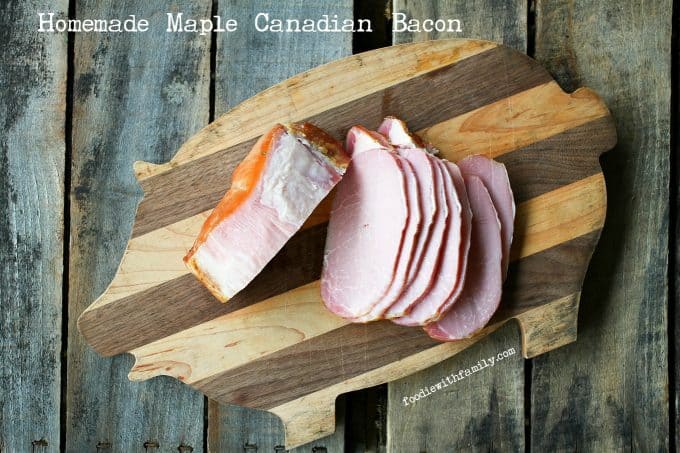
That challenge, even though it wasn’t directly delivered to me, got me to thinking. If I could make regular old American bacon, why in the world couldn’t I make some fabulous North-of-the-border bacon?
Canadian Bacon is a many splendored thing. Because it’s so lean, you really only need to heat it through rather than fry it up like our beloved American bacon making it a faster, more convenient breakfast on-the-go option.
And honestly, it’s not even really Canadian. The Canadians make pea meal bacon.
You wanna know what’s nuts? How ridiculously easy MAKING Canadian bacon is.
Mercy, though, the ease with which this is prepared pales in comparison to how insanely delicious the end product is. Cured pork loin with mild maple and sage flavours eclipses any commercially available Canadian bacon I’ve ever had in my entire life.
My unofficially official taste-testing panel of my husband and sons agreed completely. In fact, this Canadian bacon has been added to not one, not two, but THREE birthday meal requests!
What Is Canadian Bacon
The perfect Canadian bacon starts with a good chunk of readily available boneless pork loin. I’m not talking about pork tenderloins, I’m talking about center cut, lean pork loin.
Many grocers sell this in a vacuum sealed package in large amounts. This recipe makes enough brine for 4 pounds of loin, but you can upsize the brine if you get a monstrous huge loin, eh? (And I’m sorry, but that really was more of a Michigan ‘eh’ than a Canadian one…)
I feel obliged to make Canadian bacon pretty Canadian so I added a goodly slug of Grade B dark maple syrup to the brine. It gives it that something special!
If you can’t get the dark Grade B, go for a good A. The darker the syrup, the stronger the maple flavour!
If you can’t get maple syrup at all, feel free to sub in our brown sugar homemade pancake syrup. The result will be delicious if different.
Fresh sage is where it’s at, folks. Grab a bundle from the grocery store, or a handful from your neighbor’s garden (with their permission, of course!) but do splurge on the fresh sage.
And hot on the heels of my fresh sage argument, I’m going to tell you that dried whole leaf thyme is a-okay here! Fresh thyme is nice, but not quite as crucial to the finished product as the fresh sage.
Before dunking the pork loin into the brine, trim as much fat off as you can. You don’t need to be surgical, as it will be easier to remove from the Canadian Bacon AFTER it’s smoked or cooked in the oven. You can reserve the cured, smoked or roasted fat to render and add to beans.
I prefer to cut the pork loin to pieces that are a size that fit comfortably into a gallon freezer bag so they stay submerged in the brine like good little bacon.
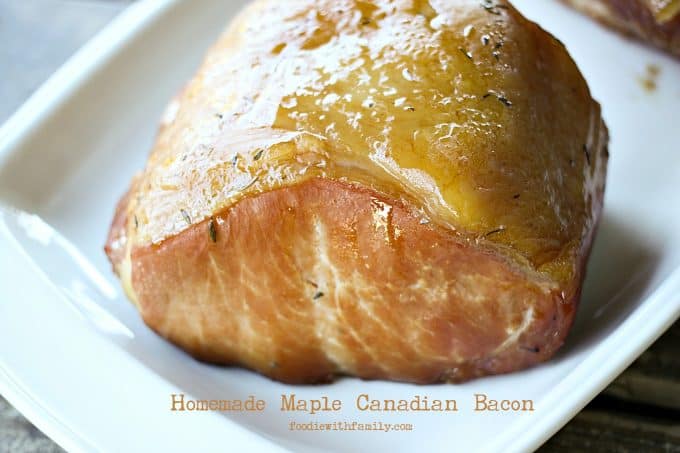
Smoking the brined Canadian Bacon over applewood is FABULOUS and preferable, but if you have no access to a smoker, you can put it in a very low temperature oven (with a little smoke box if you own one!) until the internal temperature reaches 150°F. I’ve included instructions for both methods in the recipe.
This keeps in the refrigerator for up to 10 days (courtesy of the pink salt used in the brine) but keeps far longer if tightly wrapped and stashed in the freezer.
Speaking of pink salt. I did choose to use it here.
I adapted my recipe from Michael Ruhlman’s “Charcuterie” and he makes a pretty powerful argument in favour of its use. If you choose to omit this, understand that it will shorten the shelf life in the refrigerator as well as alter the colour to more of a brown than a pink.
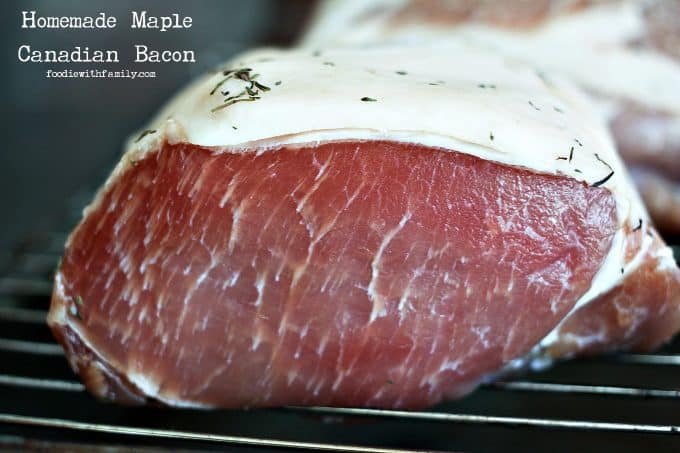
It also increases the risk of bacterial growth in the meat. Please note this means curing powder pink salts not Himalayan. The technical term for this is Prague Powder #1.
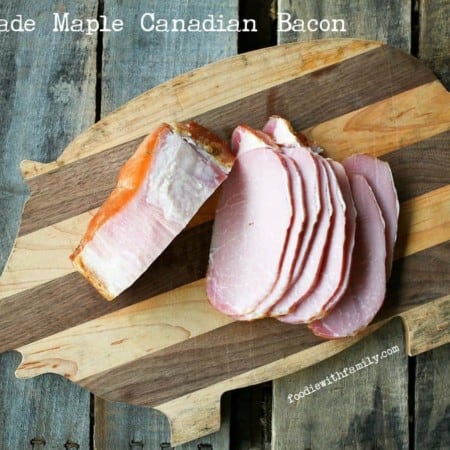
Homemade Maple Canadian Bacon {Smoker Optional}
Rate RecipeIngredients
- 1 gallon water 4 liters
- 1 1/2 cups Morton’s kosher salt 350 grams
- 1 cup raw sugar 250 grams
- 8 teaspoons pink salt 42 grams
- 1 cup Grade B Dark Maple Syrup 236 ml
- 1 bunch fresh sage
- 1 tablespoon dried thyme
- 2 garlic cloves peeled and smacked with the side of a knife to lightly crush
- 4 pounds boneless pork loin excess fat removed
Instructions
- Combine the water, salt, sugar, pink salt, maple syrup, sage, thyme, and garlic cloves in a stockpot. Bring to a simmer and stir to dissolve the sugar and salt. Remove from the heat and refrigerate until chilled all the way through. Trim the pork loin down to fit into two or more gallon sized resealable freezer bags. Insert the pork loin in the bags, then pour the cooled brine into the bags to cover the loins. Squeeze as much air as possible from the bags, then place the filled bags in a high-sided roasting pan and place the pan in the refrigerator for 72 hours.
- After 72 hours, drain the brine, rinse the pork loins, and place on a rack over a baking sheet. Put that back into the refrigerator for 24 hours to air dry.
To Smoke the Canadian Bacon:
- Hot smoke at 200°F over applewood chips for 2 to 3 hours, according to your smoker manufacturer’s instructions, or until the internal temperature of the pork loin reaches 150°F.
To Roast the Canadian Bacon:
- Preheat your oven to 200°F. Take the air-dried pork loin and put it in the oven still on its rack over its pan, and cook until the internal temperature reaches 150°F.
- Trim any remaining excess fat, then allow to cool to room temperature. Wrap the pork tightly and refrigerate for up to 10 days or wrap in a double layer of plastic wrap then a layer of foil and freeze for up to 6 months.
Nutrition
Nutritional information is an estimate and provided to you as a courtesy. You should calculate the nutritional information with the actual ingredients used in your recipe using your preferred nutrition calculator.
did you make this recipe?
Make sure to tag @foodiewithfam on Instagram and #hashtag it #foodiewithfamily so I can check it out!
Need a little help finding some Pink Salts for curing your meat? Here’s a handy-dandy Amazon affiliate link to some Prime eligible Pink Salt!
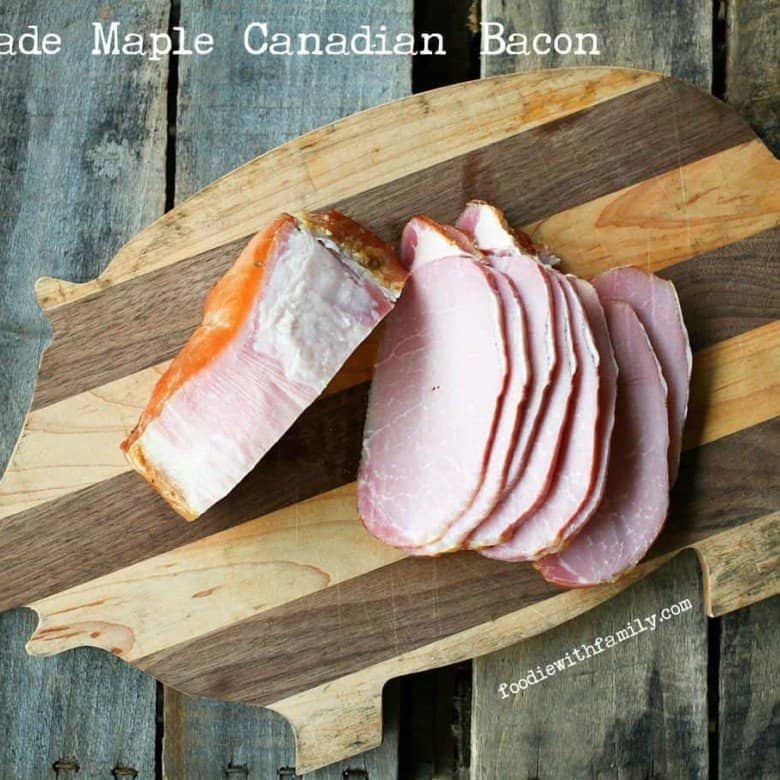



Reader's Thoughts...
Marilou Lacy says
I have my pork loin brining and there is some brine leftover and I remembered the costco pork sirloin roasts I have in the freezer. I wonder how they would work brined and smoked. Any suggestions or advise? Love this sight and have it on almost daily.
Jason says
In answer to Rie’s question. They are not interchangeable unfortunately but pink curing salt is readily available online. I got a 5Lb tub from sausagemaker.com a couple of years back when I first started trying to cure my own bacon. (I’m a brit expat in the US and I miss the bacon I am used to). The one you need is Instacure #1. The 5lb tub will probably last me a thousand years but you can get it in smaller amounts from other stores, even William’s Sonoma sells it as “Curing Salt”.
To Nancy’s point, it is very important to note that “Pink Salt” is a specific compound formulated with sodium nitrite to prevent spoilage and botulism in curing meat. The Himalayan table salts with a pink hue that are popular in stores like Trader Joe’s these days are NOT the same and will not cure your bacon safely.
A word of warning though. Once you try homemade bacon and start experimenting with adding aromatics to your brine (juniper is awesome!) you will never go back to store bought : )
Aly ~ Cooking In Stilettos says
Rebecca – I swear – your culinary projects are legendary. Homemade Canadian Bacon – GENIUS!! I have got to try this!
Angela {Mind Over Batter} says
Did you hear that? That was my drool hitting my keyboard. I never met a piece of pork I didn’t like. It’s my “go to” meat. If pigs come down with, like, “mad pig” disease I’m going to need someone to put me down. Let’s talk about this Canadian bacon. Yes, people say it’s just ham, but no…. no… it’s bacon! And I LOVE THIS BACON!
Renee - Kudos Kitchen says
I would have never considered making my own Canadian bacon..until now. You make it look so easy. Thank you for sharing this recipe. I can’t wait tot try it. Pinning and stumbling.
Nutmeg Nanny says
I WANT this Canadian bacon! We have a big smoker sitting in our basement that needs some attention.
Melissa from HungryFoodLove.com says
Smoker optional? Life changer!
Lora @cakeduchess says
I knew that book would be fabulous…must get my hands on it. Love this recipe. I’m dreaming of dicing it and throwing it into some fun fall/winter soups. I’m dreaming of taking a bite now!
Nancy says
This looks yummy, and healthier than regular (but also fabulous) bacon. I take it that pink salt is something specific, and completely different from Himalayan pink salt?
Brenda@Sugar-Free Mom says
I never ever would have ever attempted to make Canadian bacon at home, you just rock!
Amanda @The Kitcheneer says
This is AMAZING! I need to make this! Great tutorial!
Ginny McMeans says
You are very talented Rebecca! Great photo instructions.
Uvon Tucker says
Question: For those of us without a smoker or smoke box, would adding a little Liquid Smoke at some point in the process have any benefit?
Rebecca says
Hmmmm. That’s a good question. I imagine it might be nice in a small amount, Uvon, but not having tried it I can’t guarantee results! Please let me know if you do try it and how you like it!
Gerry says
You could put in a smoker box as long as you have a good fan over your oven. Mine smokes wite a bit. I have a smoker and make Canadian bacon all the time, have 3 large loins on the go now. I also use a smoker box regularly in my bbq, it adds a nice smoky flavor.
Ashley @ Wishes and Dishes says
This made me laugh – especially with the “eh?” We have a lot of family from Toronto and we laugh at that all the time. Ok and now I want bacon! This is great, Rebecca!
Angie | Big Bear's Wife says
I think that I actually prefer Canadian bacon over regular bacon. My husband is the “smoker” of the family so I’ll have to get him to make this for us!
claire @ the realistic nutritionist says
I just love you.
Liz @ The Lemon Bowl says
Omg I love Canadian bacon but I’ve never thought to make it – I want to eat all of it!!
Amy @Very Culinary says
Looooove canadian bacon. It’s one of my favorite pizza toppings (and of course with Eggs benedict. Of. Course.) Your pictures are bootiful. And also? I want that cutting board!
Nancy Long says
will be trying this the next time I make eggs benedict
Rie says
Never been a big fan of Canadian bacon, but this looks so much better. (Of course homemade is always better) Will be trying this out. (Related) Question: are pink salt and salt peter (incorrect spelling) able to be substituted equally? If I need a tablespoon of one, can I just use a tablespoon of the other? Thanks. I learn so much from you blog.
Rebecca says
Hi Rie! I’m not certain whether they’re interchangeable. I know the FDA banned using it, meaning saltpeter, for curing meats a while back and I don’t think I’ve ever actually used saltpeter. I can’t find a definitive answer for that online either! Google has failed me! 😀
Rie says
Thanks for the response. I can’t find the answer either! Guess I’ll just have to give it a try and see.
Amy says
Saltpeter is potassium nitrate. Pink salt is sodium chloride+ other minerals
“In addition to sodium, potassium, iron, magnesium, calcium, and copper are all present in trace amounts. These additional minerals transfer color to the salt, with iron creating the pleasing pink color.”
They really aren’t interchangeable
Garry says
FYI saltpeter (sodium niTRATE Na NO3) and pink salt (sodium niTRITE Na NO2 are NOT the same and most saltpeter I’ve encountered is potassium nitrate, the active ingredient in black powder. I know that at one time or another they have all been used for the same thing(meat preservation) as well as “salt,” sodium chloride. Potassium chloride is used in “salt” substitutes. Both can be taken internally but whereas sodium chloride can be taken I.V. (saline solution) , potassium chloride will cause cardiac failure within minutes. Interesting. Don’t be misled by the term salt- There are zillions of different ones. I stick with the “store bought” stuff with good results and the price is modest compared with the meat.
Hope this helps, LOL, Garry
Dan says
I’ve heard salt petre is not good for you, and should not be used… cure #1 is safer and no difference in flavor… salt petre is better for cured meat that is intended for no reverberation storage. That is what my little bit of research found.
theresa says
get prague powder cure # 1 ….I get on amazon very reasonable